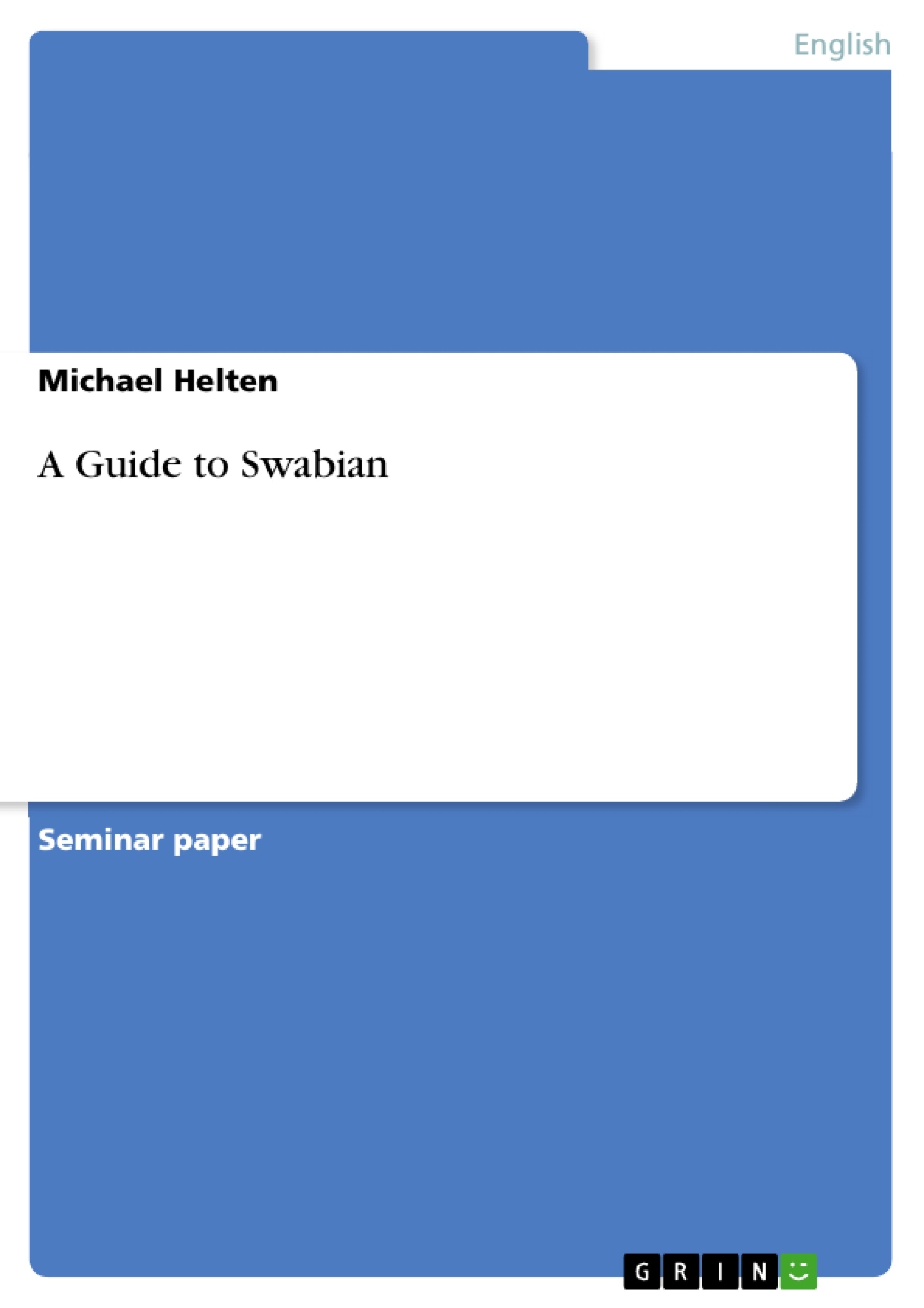This guide to Swabian is aimed at American college and university students who have an interest in language and who have studied German for at least a year, and of course for anyone else interested in the subject. The aim is to make people who are already familiar with the general phonetic patterns of German and English aware of how extremely different Swabian, as an example of one of the many and diverse dialects of German, can sound from the textbook Standard German that is generally taught – for a good reason, of course, since the standard variety, like in most languages, is the only variety that has an agreed upon spelling and it will be the most widely understood. Accompanied by a number of speech samples that will illustrate the phonemic sounds of Swabian and give a general feeling for the dialect, the sections on consonants and vowels will focus on the major differences between Standard German and Swabian, and on what sounds in the inventory of English may prove helpful in the pronunciation of Swabian. First of all, however, we should turn towards how Swabian is located, that is locally, but also concerning its linguistic background and surroundings.
1. Introduction
This guide to Swabian is aimed at American college and university students who have an interest in language and who have studied German for at least a year, and of course for anyone else interested in the subject. The aim is to make people who are already familiar with the general phonetic patterns of German and English aware of how extremely different Swabian, as an example of one of the many and diverse dialects of German, can sound from the textbook Standard German that is generally taught – for a good reason, of course, since the standard variety, like in most languages, is the only variety that has an agreed upon spelling and it will be the most widely understood. Accompanied by a number of speech samples that will illustrate the phonemic sounds of Swabian and give a general feeling for the dialect, the sections on consonants and vowels will focus on the major differences between Standard German and Swabian, and on what sounds in the inventory of English may prove helpful in the pronunciation of Swabian. First of all, however, we should turn towards how Swabian is located, that is locally, but also concerning its linguistic background and surroundings.
2. Swabian in Context
Swabian derived its name from the former tribe of the Suebi who “occupied the area between the Upper Rhine and the Upper Danube in the first century AD (Ross 337)[1].” It is the language of the Southwestern area of Germany that covers all of the former kingdom of Württemberg and parts of Baden (now the two parts that make up the Bundesland Baden-Württemberg). In the east it also extends into Bavaria to about as far as the Lech River, the western border is drawn by the massif of the Black Forest. Swabian emerged from Allemanic, the Upper German dialect that is spoken in the southern areas of Germany that border Switzerland.
Like German, Swabian itself is very versatile, too. Within the dialect the literature usually distinguishes between colloquial, regional and basic dialect forms, the colloquial version being the “standard variety” of the dialect, the regional dialects more general subdivisions, and the basic dialect a form that will be different from village to village, and considerably so. The two major regional dialects within the Swabian speaking area are normally characterized as the gwä -dialect vs. the gsi -dialect after the different forms of the past participle of ‘to be’ (in stead of ‘gewesen’ from ‘sein’). The latter is closer to Allemannic both linguistically and geographically, the former, however, is the regional form this guide is describing, mostly because the author and therefore also the speech samples are from this variety.
3. Speech Samples
As was mentioned before, this guide will be accompanied by a number of speech files that will make it easier to grasp the phonemes and the dialect as a whole than mere phonetic description can. The files were recorded at Stony Brook University by the author himself, who is a native but not a very active speaker of Swabian. The samples should give at least a good approximation of how Swabian sounds. Further speech samples can be found on a webpage published by Naeger of the University of Marburg that is dedicated to German dialects in general. There, the reader will find realizations of the Standard German sentence “Du bist noch nicht groß genug, um eine Flasche Wein auszutrinken. Du musst zuerst noch wachsen und älter werden“ (You are not big enough yet to empty a bottle of wine. You will first have to grow and get older) in three different Swabian dialect forms and he will also be able to compare it with the sentence’s realization of a great variety of speakers of other German dialects.
[...]
[1] Most general facts are taken from Ross, Charles. The Dialects of Modern German. London: Routledge, 1990.
- Arbeit zitieren
- Michael Helten (Autor:in), 2004, A Guide to Swabian, München, GRIN Verlag, https://www.grin.com/document/57041
-

-

-

-
Laden Sie Ihre eigenen Arbeiten hoch! Geld verdienen und iPhone X gewinnen. -

-
Laden Sie Ihre eigenen Arbeiten hoch! Geld verdienen und iPhone X gewinnen. -

-
Laden Sie Ihre eigenen Arbeiten hoch! Geld verdienen und iPhone X gewinnen. -

-
Laden Sie Ihre eigenen Arbeiten hoch! Geld verdienen und iPhone X gewinnen. -

-
Laden Sie Ihre eigenen Arbeiten hoch! Geld verdienen und iPhone X gewinnen.

